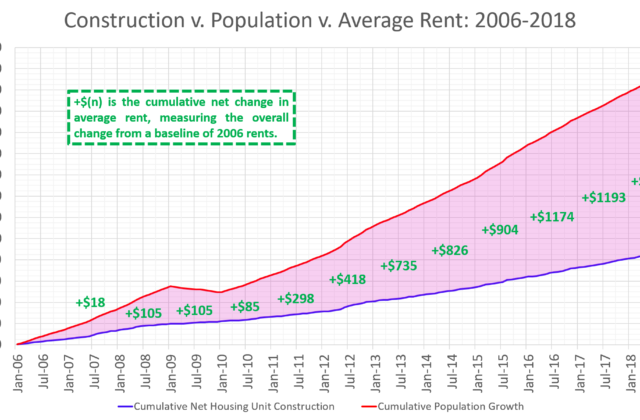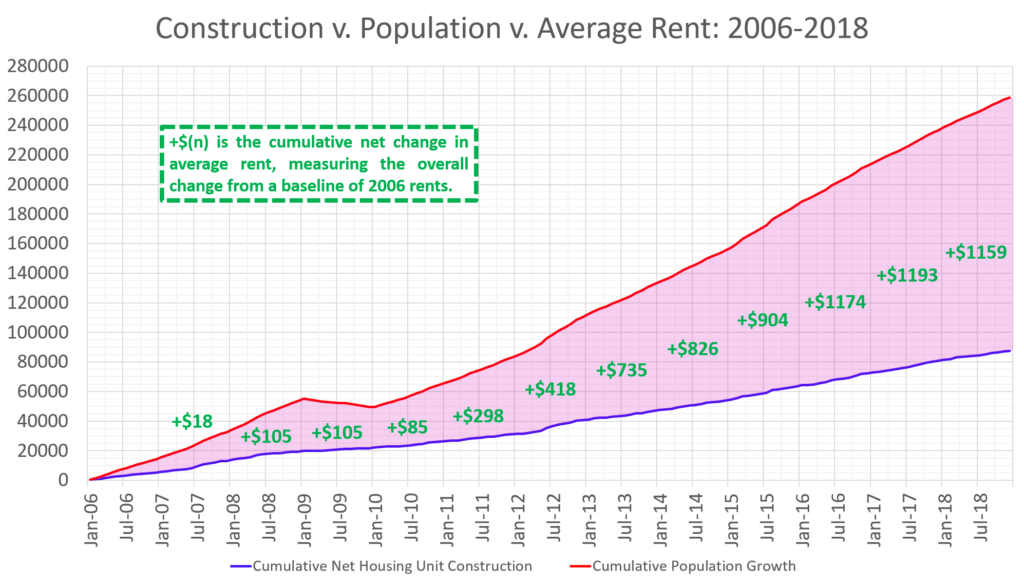Marketing the Market: Seattle’s Housing Shortage
Jordan Crawley is a policy and administrative consultant for entrepreneurs in the Seattle area. He formerly worked for the US Army as an Intelligence Analyst and in the US House of Representatives. He currently works with local campaigns, performing policy and data analysis.
The post-recession boom, beginning in the summer of 2009, brought population increases to Seattle that outpaced housing construction and sent rent soaring. Housing affordability now dominates our political discourse with most suggested resolutions (e.g. slowing market-rate housing construction, hastening subsidized housing construction, and rent control) presume more government intervention and public dollars are the answer. Alternatively, experts argue these interventions likely caused, and perpetuate, our dilemma.
In 1985, King County established an “urban growth boundary” (UGM), limiting eastward development. Washington’s Growth Management Act(1990) expanded King County’s UGM concept as a requirement to the states rapidly growing counties and cities. The prescriptive land use policies of the GMA and UGM established a new goal – channel all new growth into spaces already urbanizing. Since its effective date in 1992, the UGM has remained largely intact, but some flaws have become more apparent with regional population increases. While intending to be “comprehensive”, the GMA’s growth management plans fail to facilitate densification and are generally weak on land use. In fact, since the 1990’s, prescriptive land use policies have repeatedly led to reduced affordability and reduced volume of construction.
Researchers from World Bank, Organization for Economic Co-operation and Development, the United Kingdom, Central and Reserve banks, and universities across the United States (including the University of Washington) argue against prescriptive land use. The common understanding is that prescriptive land use directly causes skyrocketing housing costs, slow permitting to a crawl, and allow inequity to thrive.
From 2006 to 2018, Seattle’s population increased by 170,000 people. During the same time, Seattle’s housing market increased by just 87,000 units. Over thirteen years we built about half the housing necessary to meet demand, resulting in significant and sustained rent increases. During the recession (2008-2009), Seattle’s population was stagnant. Because housing supply kept pace with demand, average rent remained the same. In 2010, when Seattle experienced a net decrease in population, supply drew even closer to demand – rents decreased by $20 per month. However, once Seattle recovered and population began outpacing construction, rents spiked every year. By the thirteenth, rents had increased nearly $1,200 per month – correlating very strongly (0.9728) with the difference in population and housing construction.
Poorly managed housing markets were a major cause in trigger the recession, but a more responsive housing supply would likely have limited price volatility and encouraged labor mobility. Overall, speeding up recovery and lessoning the long-term impacts to come. Jan Brueckner from University of California-Irvine put it this way:
“Well-meaning interventions that cause land use outcomes to diverge substantially from free market outcomes run the risk of generating net social losses. The problem is that the expected benefits from large interventions may be swamped by unanticipated losses, which may be overlooked by government officials with an incomplete understanding of the operation of real estate markets.”
By limiting where we build without significantly changing how we build where we build, and without establishing some offsetting benefits, “well-meaning interventions” like rent controls, taxes on housing and development, and growth boundaries caused our current shortage. This disequilibrium has socially significant consequences. If legislators are dead set on maintaining the UGM and are serious about providing more housing locally and regionally, they must also implement systems that significantly expand growth in urban zones. Through more responsive land use regulation, we can allow development to respond to the market and finally eliminate our current, persistent housing shortage. Seattle is still growing. Rather than harsher regulation, it may be time to step back.



